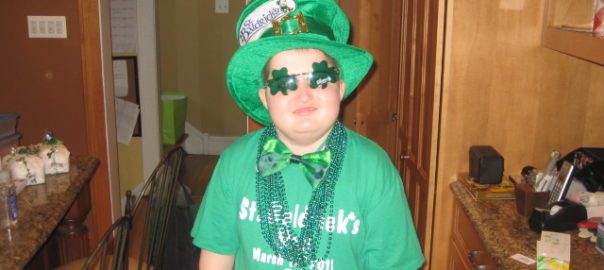Patrick was 26 months old when he was diagnosed with a benign brain tumor called an ependymoma in the year 2000. The tumor was located in the 4th ventricle. He had surgery at Children’s Memorial Hospital in Chicago (which is now Lurie Children’s Hospital). We were told he had a complete resection, meaning the doctor got it all out. We were thrilled. At his first checkup 3 months later, the tumor was back. After another successful surgery, no tumor remained. This time surgery was followed up with chemotherapy. Chemo was recommended for one year to keep the disease at bay until he turned three and could receive radiation therapy. Radiation was not advised for children under 3 years of age due to the detrimental effects on the developing brain.
His doctor gave us the chemotherapy protocol to read. We were shocked that in the year 2000, the protocol was dated 1985. When we questioned his doctor we were told that is the best they had to offer, that this was the standard protocol. Nothing new had been developed for children like Patrick in over 15 years! It was then we learned pediatric cancer research and drug development is vastly underfunded. This began our quest to help fund better treatments for children. We participated in many events to help fund research and eventually a cure. It was at this time a friend coined the term “Pat Mac’s Pack”. Pat Mac’s Pack consisted of family, friends, neighbors and classmates who came out to support Patrick and participate in these events.
A common adverse effect of one of the drugs Patrick was taking was hearing loss. Patrick now had to wear hearing aids. The disease was making life more difficult. Also adding to Patrick’s struggles were learning difficulties due to the radiation. He required extra help in his studies at school.
Two years after Patrick’s radiation was complete, the tumor recurred. Again another complete surgical resection only this time the doctor used a new device called Intrabeam. This is radiation delivered during the surgery. The area where the tumor was removed is radiated intra-operatively. During this surgery, Patrick lost all hearing in his right ear due to nerve damage. He now had to use an FM system in school to hear the teacher. Always the joker, he had to remind the teacher to turn it off as he was sometimes privy to the teachers’ lunchtime conversations.
Six years into his battle, a spot developed in a different part of the brain, the third ventricle. This area of the brain is much more difficult to access during surgery. This is when his chance for a cure changed. When the tumor was biopsied, it had changed grade. It was now anaplastic or malignant. His surgeon did not want to attempt surgery in this part of the brain because of its deep location and the possible adverse outcomes. He received yet another type of radiation called Gamma Knife. He was the youngest patient to ever receive this type of radiation at Northwestern Memorial Hospital. Two months later the tumor was back and Patrick was started on a new chemotherapy, only this time it was a clinical trial.
It was at this time we learned that none of the drugs available to children in clinical trials were developed specifically for brain tumors, let alone pediatric brain tumors. Instead it might be a drug designed for adult pancreatic cancer or breast cancer. The best we had was a gamble that maybe one of these drugs would keep the tumor stable for a while.
This drug worked for 20 months. When the tumor started to grow again, the doctor agreed to try another surgery. Surgery #8 was done endoscopically. Patrick started another clinical trial. Seven months later a new spot appeared in a new location, the temporal lobe. Another surgery to remove this tumor and place an indwelling catheter into his chest to deliver chemotherapy. Clinical trial # 3 started using two drugs. This time the tumor started growing again after only 2 months. Surgery #10 was done on the temporal lobe tumor. Again the entire tumor was removed and Intrabeam radiation was used again. At the same time another endoscopic surgery was done on the tumor in the middle of his brain. All this time Patrick remained in school and lived a life as fully as he could.
To prevent further tumors from developing, it was decided to do craniospinal radiation. This is radiation of the entire brain and spine. This is rarely used on young children and only when there are very few options left. As parents we reluctantly agreed to try. Patrick at age 11 wanted to do everything he could to fight this disease. Despite his struggles he loved life and loved spending time with his family and friends.
His MRI scan remained clean for 6 months. Another new spot developed back in the middle of his brain. Clinical trial #4 began. At this time we started investigating alternative therapies. Patrick began to work with a nutritionist, met with an Amish herbalist, and dramatically changed his diet (well, he tried anyway!). He was very willing to do anything he could to help his chances of surviving.
Five months after starting his last clinical trial, the tumor began to grow again and endoscopic surgery #12 was done. This time only part of the tumor could be removed. It was at this time he developed hydrocephalus and required the placement of a shunt. Shunts can be very difficult to manage due to malfunctions and blockages. He started his 5th clinical trial, again with the hope of minimizing growth. Unfortunately two months later there was massive growth of the tumor in the middle of his brain. There were no surgical, chemotherapy or radiation options left.
We heard about a treatment being done in another state called Laser Tumor Ablation. It was new and experimental Again Patrick wanted to try it. With MRI guidance, a wire is inserted into the tumor, heat is delivered with the hope of destroying the tumor. The size of the tumor was just inside the paramaters of acceptance into this trial. Patrick received two ablations and then we were told the tumor had metastasized to his spine. During this time Patrick’s shunt had many blockages, requiring frequent hospitalizations for revisions, and in some cases shunt replacements with lower flow models. Patrick had 2 more ablations, which did result in some stability.
His doctor agreed to try one more surgery to debulk the tumor. This was followed by one final ablation. Following this ablation, Patrick coded, he required intubation and developed an endocrine disorder called Diabetes Insipidus. He remained hospitalized for 3 weeks. Following extubation, he never regained his full mental capacity, or his ability to speak in full sentences. We flew him home to try rehab, but he was never able to recover enough to participate. He had hospice care for 2 months. Patrick died in October 2011 at 13 years old, 11 years 8 months after his first diagnosis.


